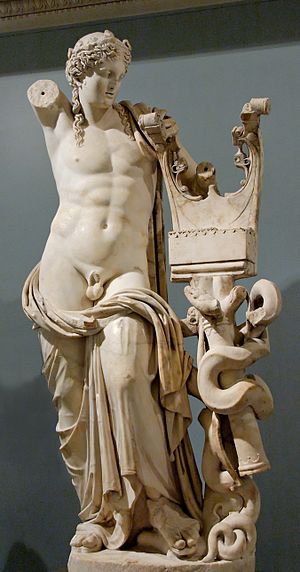Apollo of Cyrene
| Apollo of Cyrene | |
|---|---|
 The Apollo of Cyrene on display in the British Museum | |
| Material | Marble |
| Size | 2.29m high |
| Created | 2nd Century AD/CE[1] |
| Present location | British Museum, London |
| Registration | 1861.7-25.1 |
The Apollo of Cyrene is a colossal Roman statue of Apollo found at the ancient city of Cyrene, Libya. It was unearthed at the site along with a large number of other ancient sculptures and inscriptions which were presented to the British Museum in 1861.[2][1]
Discovery
This enormous sculpture was discovered in the mid-nineteenth century at the Temple of Apollo at Cyrene in Libya. It was excavated by the
archaeologists Captain Robert Murdoch Smith
and Commander Edwin A. Porcher. The statue was found broken into 121 pieces, lying near the large plinth where it originally stood. The fragments were later reassembled in the British Museum to create a relatively intact statue. Some parts are missing, including the right arm and the left hand.
Description
The statue dates to the 2nd century AD, and is a copy of a Hellenistic work probably dating to between 200 and 150 BC.Hellenistic origin.
Temple of Apollo
The statue was probably the main cult image in the Temple of Apollo at Cyrene. The deity would have acted as the focal point for worship and ritual activity.
Gallery
-
Alternative view of the statue
References
Further reading
- L. Burn, The British Museum book of Greek and Roman Art, revised edition (London, The British Museum Press, 1999)
- P. Higgs, 'The Cyrene Apollo', History Today, 44 (11) (), pp. 50–54

